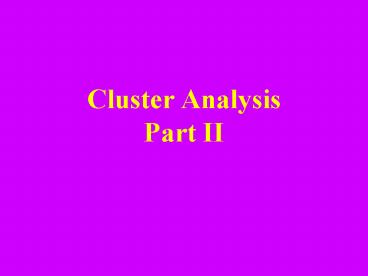Cluster Analysis Part II - PowerPoint PPT Presentation
1 / 20
Title:
Cluster Analysis Part II
Description:
(AGNES) divisive (DIANA) AGNES (Agglomerative Nesting) Introduced in Kaufmann and ... Inverse order of AGNES. Eventually each node forms a cluster on its own ... – PowerPoint PPT presentation
Number of Views:70
Avg rating:3.0/5.0
Title: Cluster Analysis Part II
1
Cluster AnalysisPart II
2
Learning Objectives
- Hierarchical Methods
- Density-Based Methods
- Grid-Based Methods
- Model-Based Clustering Methods
- Outlier Analysis
- Summary
3
- What is Cluster Analysis?
- Types of Data in Cluster Analysis
- A Categorization of Major Clustering Methods
- Partitioning Methods
- Hierarchical Methods
- Density-Based Methods
- Grid-Based Methods
- Model-Based Clustering Methods
- Outlier Analysis
- Summary
4
Hierarchical Clustering
- Use distance matrix as clustering criteria. This
method does not require the number of clusters k
as an input, but needs a termination condition
5
AGNES (Agglomerative Nesting)
- Introduced in Kaufmann and Rousseeuw (1990)
- Implemented in statistical analysis packages,
e.g., Splus - Use the Single-Link method and the dissimilarity
matrix. - Merge nodes that have the least dissimilarity
- Go on in a non-descending fashion
- Eventually all nodes belong to the same cluster
6
A Dendrogram Shows How the Clusters are Merged
Hierarchically
Decompose data objects into a several levels of
nested partitioning (tree of clusters), called a
dendrogram. A clustering of the data objects is
obtained by cutting the dendrogram at the desired
level, then each connected component forms a
cluster.
7
DIANA (Divisive Analysis)
- Introduced in Kaufmann and Rousseeuw (1990)
- Implemented in statistical analysis packages,
e.g., Splus - Inverse order of AGNES
- Eventually each node forms a cluster on its own
8
More on Hierarchical Clustering Methods
- Major weakness of agglomerative clustering
methods - do not scale well time complexity of at least
O(n2), where n is the number of total objects - can never undo what was done previously
- Integration of hierarchical with distance-based
clustering - BIRCH (1996) uses CF-tree and incrementally
adjusts the quality of sub-clusters - CURE (1998) selects well-scattered points from
the cluster and then shrinks them towards the
center of the cluster by a specified fraction - CHAMELEON (1999) hierarchical clustering using
dynamic modeling
9
BIRCH (1996)
- Birch Balanced Iterative Reducing and Clustering
using Hierarchies, by Zhang, Ramakrishnan, Livny
(SIGMOD96) - Incrementally construct a CF (Clustering Feature)
tree, a hierarchical data structure for
multiphase clustering - Phase 1 scan DB to build an initial in-memory CF
tree (a multi-level compression of the data that
tries to preserve the inherent clustering
structure of the data) - Phase 2 use an arbitrary clustering algorithm to
cluster the leaf nodes of the CF-tree - Scales linearly finds a good clustering with a
single scan and improves the quality with a few
additional scans - Weakness handles only numeric data, and
sensitive to the order of the data record.
10
Clustering Feature Vector
CF (5, (16,30),(54,190))
(3,4) (2,6) (4,5) (4,7) (3,8)
11
CF Tree
Root
B 7 L 6
Non-leaf node
CF1
CF3
CF2
CF5
child1
child3
child2
child5
Leaf node
Leaf node
CF1
CF2
CF6
prev
next
CF1
CF2
CF4
prev
next
12
CURE (Clustering Using REpresentatives )
- CURE proposed by Guha, Rastogi Shim, 1998
- Stops the creation of a cluster hierarchy if a
level consists of k clusters - Uses multiple representative points to evaluate
the distance between clusters, adjusts well to
arbitrary shaped clusters and avoids single-link
effect
13
Drawbacks of Distance-Based Method
- Drawbacks of square-error based clustering method
- Consider only one point as representative of a
cluster - Good only for convex shaped, similar size and
density, and if k can be reasonably estimated
14
Cure The Algorithm
- Draw random sample s.
- Partition sample to p partitions with size s/p
- Partially cluster partitions into s/pq clusters
- Eliminate outliers
- By random sampling
- If a cluster grows too slow, eliminate it.
- Cluster partial clusters.
- Label data in disk
15
Data Partitioning and Clustering
- s 50
- p 2
- s/p 25
- s/pq 5
x
x
16
Cure Shrinking Representative Points
- Shrink the multiple representative points towards
the gravity center by a fraction of ?. - Multiple representatives capture the shape of the
cluster
17
Clustering Categorical Data ROCK
- ROCK Robust Clustering using linKs,by S. Guha,
R. Rastogi, K. Shim (ICDE99). - Use links to measure similarity/proximity
- Not distance based
- Computational complexity
- Basic ideas
- Similarity function and neighbors
- Let T1 1,2,3, T23,4,5
18
Rock Algorithm
- Links The number of common neighbours for the
two points. - Algorithm
- Draw random sample
- Cluster with links
- Label data in disk
1,2,3, 1,2,4, 1,2,5, 1,3,4,
1,3,5 1,4,5, 2,3,4, 2,3,5, 2,4,5,
3,4,5
3
1,2,3 1,2,4
19
CHAMELEON
- CHAMELEON hierarchical clustering using dynamic
modeling, by G. Karypis, E.H. Han and V. Kumar99
- Measures the similarity based on a dynamic model
- Two clusters are merged only if the
interconnectivity and closeness (proximity)
between two clusters are high relative to the
internal interconnectivity of the clusters and
closeness of items within the clusters - A two phase algorithm
- 1. Use a graph partitioning algorithm cluster
objects into a large number of relatively small
sub-clusters - 2. Use an agglomerative hierarchical clustering
algorithm find the genuine clusters by
repeatedly combining these sub-clusters
20
Overall Framework of CHAMELEON
Construct Sparse Graph
Partition the Graph
Data Set
Merge Partition
Final Clusters































